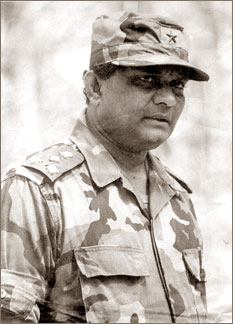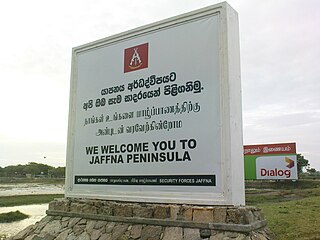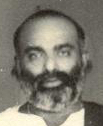
The history of Sri Lanka is unique because the relevance and richness of it extends beyond the areas of South Asia, Southeast Asia and the Indian Ocean. The early human remains which were found on the island of Sri Lanka date back to about 38,000 years ago.

Lieutenant General Denzil Lakshman Kobbekaduwa, RWP, RSP, VSV, USP was a senior Sri Lankan Army officer who served in the 1971 Insurrection and the Sri Lankan Civil War.

Major General Vanigamuni Indrajith Vijeyakumar Mendis Wimalaratne, RWP, RSP, VSV, USP was a senior Sri Lanka Army officer. One of the most distinguished field commanders in Sri Lanka, Wimalaratne raised the Gajaba Regiment, he commanded the 1st Brigade during the Vadamarachchi Operation, he commanded the Amphibious Task Force Commander during Operation Balavegaya and was the Commander Security Forces – Jaffna at the time of his death in a land mine explosion at Point Arali in the Kayts Island while making preparations to re-capture Jaffna.

The 1958 anti-Tamil pogrom and riots in Ceylon, also known as the 58 riots, refer to the first island-wide ethnic riots and pogrom to target the minority Tamils in the Dominion of Ceylon after it became an independent dominion from Britain in 1948. The riots lasted from 22 May until 29 May 1958 although sporadic disturbances happened even after the declaration of emergency on 27 May 1958. The estimates of the murders range, based on recovered bodies, from 158 to 1,500. Although most of the victims were Tamils, Sinhalese and their property were also affected by retaliatory attacks by Tamil mobs throughout the Batticaloa and Jaffna districts. As the first full-scale race riot in the country in over forty years, the events of 1958 shattered the trust the communities had in one another and led to further polarisation.

The 1977 anti-Tamil pogrom in Sri Lanka followed the 1977 general elections in Sri Lanka where the Sri Lankan Tamil nationalistic Tamil United Liberation Front won a plurality of minority Sri Lankan Tamil votes. In the elections, the party stood for secession. An official government estimate put the death toll at 125, whereas other sources estimate that around 300 Tamils were killed by Sinhalese mobs. Human rights groups, such as the UTHR-J, accused the newly elected UNP-led government of orchestrating the violence.

Samuel James Veluppillai Chelvanayakam was a Ceylonese lawyer, politician and Member of Parliament. He was the founder and leader of the Illankai Tamil Arasu Kachchi (ITAK) and Tamil United Liberation Front (TULF) and a political leader of the Ceylon Tamil community for more than two decades. Chelvanayakam has been described as a father figure to Ceylon's Tamils, to whom he was known as "Thanthai Chelva".
The origins of the Sri Lankan Civil War lie in the continuous political rancor between the majority Sinhalese and the minority Sri Lankan Tamils. According to Jonathan Spencer, a social anthropologist from the School of Social and Political Studies of the University of Edinburgh, the war is an outcome of how modern ethnic identities have been made and re-made since the colonial period, with the political struggle between minority Tamils and the Sinhalese-dominant government accompanied by rhetorical wars over archeological sites and place name etymologies, and the political use of the national past.
The 1962 Ceylonese coup d'état attempt was a failed military coup d'état planned in Ceylon. A group of Christian officers in the military and police planned to topple the government of Prime Minister Sirimavo Bandaranaike during the night of 27 January 1962. Organised by Colonel F. C. de Saram, Colonel Maurice De Mel,, Rear Admiral Royce de Mel, C.C. Dissanayake, Sydney de Zoysa and Douglas Liyanage, it was to take place in the night of 27 January 1962, but was called off as the government gained information in the afternoon and initiated arrests of the suspected coup leaders before the coup was carried out.

General Tissa Indraka Weeratunga, VSV was a Sri Lankan general. He was the former Commander of the Sri Lankan Army and the first General Officer Commanding (GOC) of the Joint Operations Headquarters (JOH), he was later Sri Lanka's High Commissioner to Canada.
The Bandaranaike–Chelvanayakam Pact was an agreement signed between the Prime Minister of Sri Lanka S. W. R. D. Bandaranaike and the leader of the main Tamil political party in Sri Lanka S. J. V. Chelvanayakam on July 26, 1957. It advocated the creation of a series of regional councils in Sri Lanka as a means to giving a certain level of autonomy to the Tamil people of the country, and was intended to solve the communal disagreements that were occurring in the country at the time.

Elangai Murugesu Vijayaretnam Naganathan was a Ceylon Tamil physician, politician, senator and Member of Parliament.

Security Forces Headquarters – Jaffna (SFHQ-J) is a regional command of the Sri Lanka Army, that is responsible for the operational deployment and command all army units stationed in and around the Jaffna Peninsula in the Northern Province.

Vallipuram Nallathamby Navaratnam was a Sri Lankan Tamil lawyer, politician and Member of Parliament.
Major General Deshamanya Alexander Richard Udugama, was a Sri Lankan soldier, politician and diplomat. Former Army Commander (1964–1966), he was elected as Member of Parliament for Matale from 1970 to 1977 and served as Sri Lankan Ambassador to Iraq from 1979 to 1982. He was accused of an alleged coup d'état in 1966.
The 1966 alleged Ceylonese coup d'état attempt was an alleged military coup planned in Sri Lanka (Ceylon). The commander of the army and several military personnel were arrested. They were later acquitted of a plot to overthrow the legally elected government.
Neil Quintus Dias commonly known as N.Q. Dias, was a Sri Lankan civil servant. A career officer of the Ceylon Civil Service, he was the Permanent Secretary of Defence and Foreign Affairs from 1960 to 1965, serving as the de facto Chief Adviser to Prime Minister Sirimavo Bandaranaike and as Ceylon's High Commissioner to India from 1970 to 1972.

Chellappah Suntharalingam was a Sri Lankan Tamil academic, politician, Member of Parliament and government minister.

General Anuruddha Leuke Ratwatte, frequently referred to as Anuruddha Ratwatte, was a Sri Lankan soldier and politician. He was a Cabinet Minister and Deputy Minister of Defence.
The Eksath Bhikkhu Peramuna was an umbrella organization consisting of two associations of Buddhist monks founded in 1956 in the Dominion of Ceylon to promote Sinhalese Buddhist interests in politics. It campaigned against the United National Party (UNP) and helped to bring the Mahajana Eksath Peramuna to power in the 1956 general election. It became defunct following the assassination of Prime Minister S. W. R. D. Bandaranaike.
Brigadier Maurice Anthony Jayaweera was a senior Sri Lanka Army officer. He served as the Chief of Staff of the Sri Lanka Army and the Commander, Task Force Anti Illicit Immigration.









